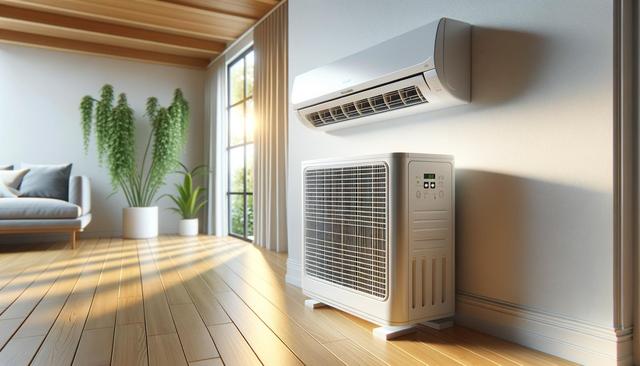What Is Ductless AC and How Does It Work?
Ductless air conditioning, also known as mini-split systems, provides a flexible and energy-efficient alternative to traditional HVAC setups. These systems consist of two main components: an outdoor compressor unit and one or more indoor air handling units. The indoor units are typically mounted high on a wall and connected to the outdoor unit through a narrow conduit that houses the power cable, refrigerant tubing, suction tubing, and a condensate drain. This setup eliminates the need for extensive ductwork, making ductless systems a practical solution for homes that lack existing ducts or where installing them would be costly and invasive.
Ductless AC systems are ideal for:
- Older homes without existing ductwork
- Room additions or renovations
- Garages, basements, or attics converted into living spaces
- Homes with hot or cold spots requiring zoned temperature control
By delivering cooling directly to different zones, ductless AC systems offer more control, reducing energy waste and enhancing comfort levels in specific areas of the home.
Easy Installation and Minimal Disruption
One of the standout features of ductless AC systems is the straightforward installation process. Traditional central air systems often require major renovations to install ducts, which can be time-consuming and disruptive. In contrast, ductless systems only need a small hole in the wall to run the conduit between the indoor and outdoor units. This typically means quicker setup times and less mess for homeowners.
For those looking to avoid the complications of window units or the structural changes required for central air, ductless AC offers a convenient alternative. Most installations can be completed in a day, depending on the number of zones being cooled. The flexibility of these systems also means they can be added incrementally, allowing homeowners to expand their cooling capacity over time without major construction.
Energy Efficiency and Cost Savings
Ductless AC systems are known for their energy efficiency, which can lead to noticeable savings on utility bills. Because they allow for zoned cooling, you can set different temperatures in different rooms, reducing the need to cool unoccupied spaces. This targeted approach to temperature control is more efficient than traditional systems that cool the entire home uniformly.
Key energy-saving features include:
- Inverter-driven compressors that adjust speed based on cooling demand
- No energy loss through ductwork, which can account for up to 30% of energy consumption in traditional systems
- Programmable remote controls and smart home integration for optimized usage
By using only the energy necessary to maintain comfort in each zone, ductless AC systems help reduce environmental impact while lowering monthly expenses.
Flexible Comfort with Zoned Cooling
One of the most attractive aspects of ductless AC is its ability to provide zoned cooling. Each indoor unit operates independently, allowing you to customize the temperature in each room or zone. This is particularly useful for households with varying comfort preferences or for rooms that tend to heat up faster than others, such as kitchens or sunrooms.
With zoned cooling, you gain:
- Personalized comfort settings for different family members
- Reduced energy consumption by cooling only the rooms in use
- Improved air quality and humidity control in specific areas
This flexibility enhances overall comfort and allows homeowners to fine-tune their environment without sacrificing efficiency or convenience.
Modern Design and Quiet Operation
Beyond functionality, ductless AC systems also offer a modern, sleek design that blends seamlessly into most interior aesthetics. The indoor units are compact and available in various styles, including wall-mounted, ceiling-recessed, and floor-mounted options. Their unobtrusive appearance makes them suitable for both contemporary and traditional decors.
Another advantage is their quiet operation. Unlike some traditional systems or window units that can be noisy and disruptive, ductless systems are designed to run quietly. This makes them especially suitable for bedrooms, nurseries, and home offices where noise levels can be a concern. With sound levels often lower than a standard conversation, ductless AC contributes to a more peaceful indoor environment.
Conclusion: A Practical Choice for Modern Comfort
Ductless AC systems offer a compelling combination of convenience, efficiency, and comfort. Whether you’re upgrading your current cooling solution or looking to enhance specific areas of your home, these systems provide a low-hassle installation with high-performance results. Their ability to deliver zoned cooling, reduce energy consumption, and operate quietly makes them a practical option for many homeowners. If you’re tired of struggling with bulky window units or complex ductwork, ductless AC could be the flexible solution you’ve been looking for.








